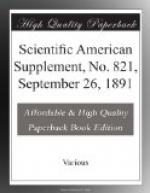The question concerning the origin of this organic substance or its combination with lime can only be answered in one way, viz., that it must have been washed by the rain water out of the paper. But since such a solid substance, easily soluble in water, is contained neither in the fresh roofing paper nor in the coal tar, the only deduction is that it must have arisen by the decomposition of the tar, in consequence of the operation of the oxygen. The lime comes from the coating substance of the roof, for which tar mixed with coal pitch was used. The latter was fused with carbonate of lime. These analyses furthermore show that the formation of the organic acid easily soluble in water depends upon the season; and that a larger quantity of it is generated in warm, sunny weather than in cold, without sunshine. This peculiarity of the solid, resinous constituents of the coal tar, to be by the operation of the atmospheric oxygen altered into such products that are readily soluble in water, makes the tar very unsuitable as a saturative substance for a roofing paper. How rapidly a paper roof can be ruined by the generation of this injurious organic acid will be seen from the following calculation: Let us suppose that an average of 132 gallons of rain water falls upon ten square feet roof surface per year, and that the arithmetical mean 0.932 of the largest (1.680) and smallest number (0.184) be the quantity of the soluble brown substance which on an average is dissolved in one quart of rain water; hence from ten square feet of roof surface are rinsed away with the rain water per year 466 grammes of the soluble decomposition products of the tar. The oxidation process will not always occur as intensely




